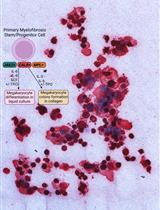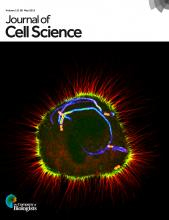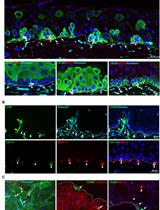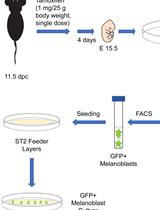- EN - English
- CN - 中文
Strategy of Isolating ‘Primed’ Tumor Initiating Cells Based on Mitochondrial Transmembrane Potential
基于线粒体跨膜电位分离“启动”肿瘤起始细胞的策略
发布: 2021年03月05日第11卷第5期 DOI: 10.21769/BioProtoc.3945 浏览次数: 4674
评审: Anonymous reviewer(s)

相关实验方案

来自骨髓增生性肿瘤患者的造血祖细胞的血小板生成素不依赖性巨核细胞分化
Chloe A. L. Thompson-Peach [...] Daniel Thomas
2023年01月20日 1495 阅读
Abstract
Various stem cells have been found to be dependent on mitochondrial energetics. The role of mitochondria in regulating the self-renewal of normal stem cells and stem-like tumor initiating cells (TICs) is increasingly being appreciated. We proposed that TIC populations have a sub population of cells that are “primed” by mitochondria for self-renewal. Using ovarian cancer model, we have developed a protocol to identify and isolate these “primed” cells using Fluorescence-Assisted Cell Sorting (FACS). We combined live cell stains for a functional marker of TICs and for mitochondrial transmembrane potential to enrich TICs with higher mitochondrial potential that form in vitro spheroids 10-fold more than the other TICs with lower mitochondrial potential. This protocol can be directly used or modified to be used in various cell types. Thus, this protocol is anticipated to be invaluable for the basic understanding of mitochondrial and energetic heterogeneity within stem cell population, and may also prove valuable in translational studies in regenerative medicine and cancer biology.
Keywords: Tumor initiating cells (肿瘤启动细胞)Background
Cellular heterogeneity in tumors poses tough challenges for cancer therapy (Magee et al., 2012). Certain tumors are arranged hierarchically with the chemotherapy resistant tumor initiating cells (also called cancer stem cells) residing at the bottom of the cellular hierarchy as they maintain the tumor through self-renewal and differentiation (Magee et al., 2012). Plasticity of the tumor initiating cells (TICs) makes them difficult to identify, isolate and study. Heterogeneity and plasticity of energetics of TICs is only beginning to be appreciated and is far from clear (Martinez-Outschoorn et al., 2017) (Intlekofer and Finley, 2019). Moreover, energetics status of TICs appears to be tumor specific, and certain TICs are dependent on mitochondrial energetics and can be eliminated by mitochondrial inhibitors (Pasto et al., 2014; Sancho et al., 2015; Viale et al., 2015; Martinez-Outschoorn et al., 2017; Spurlock et al., 2019).
Mitochondrial energetics is maintained by complex biochemical regulation of multiple bioenergetic parameters, including mitochondrial transmembrane potential maintained across the mitochondrial inner membrane (ΔΨ), which is consumed to generate ATP, heat, or reactive oxygen species. Higher mitochondrial transmembrane potential is expected to maintain higher ATP synthesis depending on various other parameters like substrate availability, etc. Previously, stem cells isolated based on mitochondrial transmembrane potential have been found to differ in their stem cell properties (Schieke et al., 2008; Sukumar et al., 2016). Recently, we developed a flowcytometric protocol to simultaneously sort cells for ΔΨ, using the red fluorescent potentiometric dye TMRE, and the activity of a functional TIC marker aldehyde dehydrogenase (ALDH), using the AldeFluor reagent (Figures 1-2) (Spurlock et al., 2019). Using such a flow cytometric sorting strategy, we were able to identify a subpopulation of human ovarian TICs with 10 fold higher self-renewing and proliferating capacity, as determined by in vitro limiting dilution assay. Thus, our protocol enables teasing out mitochondrial heterogeneity in stem cell populations.
The role of mitochondrial energetics in maintenance of normal stem cells and TICs is more appreciated as our understanding of stem cell energetics increases (Viale et al., 2015; Chandel et al., 2016; Intlekofer and Finley, 2019). Adult stem cells are majorly quiescent and considered to be highly glycolytic and release from quiescence involves metabolic/energetic shifts that remain poorly understood (Margineantu et al., 2002; Ito and Suda, 2014; Folmes and Terzic, 2016). We proposed that a subpopulation of ovarian TICs with particularly elevated mitochondrial transmembrane potential, associated with other specific mitochondrial properties, are primed for greater self-renewal and proliferation ability (Spurlock et al., 2019). Similar mitochondria based priming has been observed in hematopoietic lineage and has been linked to exit from quiescence and entry into the cell cycle for self-renewal and differentiation (Liang et al., 2020). Our protocol specifically isolates these mitochondria primed stem cells (mpSCs) by combining a TIC marker (Aldh activity) with ΔΨ. Aldh activity is a TIC marker for several tumor types, including ovarian, breast, cervical, lung, liver, prostate, bone marrow, skin, colon, and pancreatic (Marcato et al., 2011; Toledo-Guzmán, et al., 2019; Vassalli, 2019). We developed this protocol in human ovarian cancer cell lines; however, we have also performed these assays in human ovarian cancer cells derived from a mouse xenograft model as well as patient ascites. The sorted cells can be studied for stem cell or other properties with relevant methods. We have studied mitochondrial structural and functional properties of the sorted cells using our novel assay mito-SinCe2 (Spurlock et al., 2019) (example in Figure 3). This protocol is a simple and valuable tool for the isolation and study of normal and neoplastic stem cells from cell lines as well as primary cell populations. Thus, this protocol will allow a basic understanding of mitochondrial and energetic heterogeneity within stem cell population, and may also prove valuable in translational studies in regenerative medicine and cancer biology.
Materials and Reagents
1.5 ml microfuge tubes (Eppendorf, catalog number: 0 22363204 )
15 ml centrifuge tubes (Corning, catalog number: 430790 )
5 ml flow cytometry tubes (Falcon, catalog number: 352003 )
96-well Ultra-Low Attachment Plates (Corning, catalog number: 3474 )
8-well Lab-Tek II Chambered Coverglass (Nunc, catalog number: 155409 )
Appropriate cell culture materials and reagents for cells in use
DPBS (Sigma, catalog number: 59331C-1000ML )
Trypsin 0.05% (GE Healthcare Life Sciences, catalog number: SH30236.02 or similar)
AldeFluor Kit (StemCell Technologies, catalog number: 01700 )
For lineages where ALDH activity does not mark stemness, our protocol can be modified for use with any lineage by including lineage specific culture conditions and live cell markers (CD133 etc.), ensuring minimal or no overlap with TMRE fluorescence.
Tetramethylrhodamine, Ethyl Ester, Perchlorate (TMRE) (Invitrogen, catalog number: T669 )
RPMI medium for the A2780 ovarian cancer cell line in use (Corning, catalog number: 15-040-CM ) or appropriate base media
N1 supplement (Sigma, catalog number: N6530-5ML )
Insulin (Sigma, catalog number: 10516-5ML )
Sodium pyruvate (GE Healthcare Life Sciences, catalog number: SH30239.01 )
L-glutamine (GE Healthcare Life Sciences, catalog number: SH30034.01 )
Penicillin-Streptomycin Solution (GE Healthcare Life Sciences, catalog number: SV30010 )
FGF (Sigma, catalog number: F0291-25ug )
EGF (Sigma, catalog number: E9644-0.2ug )
TIC media (see Recipes)
Equipment
BD FACSAria II or similar with cytometer setup and tracking (CS&T) beads, accudrop calibration beads, 100 μm FACS cell nozzle and a minimum of 488 nm and 561 nm laser and with emission filters of 525/50 BP for AldeFlour and 576/26 BP for TMRE
Centrifuges for 1.5 ml microfuge tubes and 15 ml tubes
Standard biosafety hood with laminar flow
Standard incubator for cell culture maintained at 37 °C and 5% CO2 with humidification
Light microscope with 4× and 10× objectives
Any confocal microscope with 555 nm laser (e.g., Zeiss LSM700 )
Software
BD FACSDiva (Version 8.0.1) (with automatic compensation calculation feature) or similar for flow cytometric sorting and analyses
Procedure
文章信息
版权信息
© 2021 The Authors; exclusive licensee Bio-protocol LLC.
如何引用
Spurlock, B., Hanumanthu, V. S. and mitra, K. (2021). Strategy of Isolating ‘Primed’ Tumor Initiating Cells Based on Mitochondrial Transmembrane Potential. Bio-protocol 11(5): e3945. DOI: 10.21769/BioProtoc.3945.
分类
癌症生物学 > 癌症干细胞 > 细胞生物学试验
细胞生物学 > 细胞分离和培养 > 细胞分离
您对这篇实验方法有问题吗?
在此处发布您的问题,我们将邀请本文作者来回答。同时,我们会将您的问题发布到Bio-protocol Exchange,以便寻求社区成员的帮助。
提问指南
+ 问题描述
写下详细的问题描述,包括所有有助于他人回答您问题的信息(例如实验过程、条件和相关图像等)。
Share
Bluesky
X
Copy link










